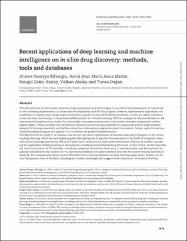Recent applications of deep learning and machine intelligence on in silico drug discovery: methods, tools and databases

Göster/
Tarih
2019Yazar
Rifaioğlu, Ahmet SüreyyaAtaş, Heval
Martin, Maria Jesus
Çetin-Atalay, Rengül
Atalay, Volkan
Doğan, Tunca
Üst veri
Tüm öğe kaydını gösterKünye
Rifaioglu AS, Atas H, Martin MJ, Cetin-Atalay R, Atalay V, Doğan T. Recent applications of deep learning and machine intelligence on in silico drug discovery: methods, tools and databases. Brief Bioinform. 2019;20(5):1878‐1912. doi:10.1093/bib/bby061Özet
The identification of interactions between drugs/compounds and their targets is crucial for the development of new drugs. In vitro screening experiments (i.e. bioassays) are frequently used for this purpose; however, experimental approaches are insufficient to explore novel drug-target interactions, mainly because of feasibility problems, as they are labour intensive, costly and time consuming. A computational field known as 'virtual screening' (VS) has emerged in the past decades to aid experimental drug discovery studies by statistically estimating unknown bio-interactions between compounds and biological targets. These methods use the physico-chemical and structural properties of compounds and/or target proteins along with the experimentally verified bio-interaction information to generate predictive models. Lately, sophisticated machine learning techniques are applied in VS to elevate the predictive performance. The objective of this study is to examine and discuss the recent applications of machine learning techniques in VS, including deep learning, which became highly popular after giving rise to epochal developments in the fields of computer vision and natural language processing. The past 3 years have witnessed an unprecedented amount of research studies considering the application of deep learning in biomedicine, including computational drug discovery. In this review, we first describe the main instruments of VS methods, including compound and protein features (i.e. representations and descriptors), frequently used libraries and toolkits for VS, bioactivity databases and gold-standard data sets for system training and benchmarking. We subsequently review recent VS studies with a strong emphasis on deep learning applications. Finally, we discuss the present state of the field, including the current challenges and suggest future directions. We believe that this survey will provide insight to the researchers working in the field of computational drug discovery in terms of comprehending and developing novel bio-prediction methods.















